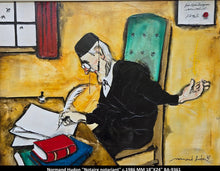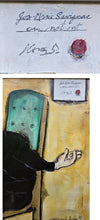BA9361 - Notaire notariant - NORMAND HUDON - 18"X24"
- Prix normal
- $15,000.00
- Prix réduit
- $15,000.00
- Prix normal
-
- Prix unitaire
- /par
Ajout d'un produit à votre panier
ORIGINAL NORMAND HUDON C.1986
NON ENCADRÉ / UNFRAMED
#balcondart #hudon #notaire
Ce tableau de Normand Hudon, intitulé "Notaire notariant", dépeint un notaire à son bureau, absorbé par son travail. Le style est caricatural et expressif, avec des traits exagérés qui soulignent la personnalité et l'activité du personnage.
Le notaire est représenté assis à un bureau en bois, concentré sur les documents devant lui. Il porte une toque noire traditionnelle, des lunettes sur le nez et une cravate blanche. Son visage est ridé et sérieux, marqué par l'âge et la concentration. Il tient une plume d'oie blanche dans sa main droite, avec laquelle il écrit sur une pile de documents. Une encrier noir est posé sur le bureau à côté des papiers.
Sur le bureau, on aperçoit également une pile de livres reliés, dont un avec une couverture rouge bien visible. Ces livres suggèrent l'importance des textes légaux dans la profession de notaire.
L'arrière-plan de la scène est un intérieur simple, avec un mur aux tons beiges texturés. Une fenêtre sur la gauche est partiellement cachée par un rideau rouge. Sur le mur de droite, un document encadré porte une inscription manuscrite et une signature. Une flèche dorée stylisée pointe vers le notaire, ajoutant un élément symbolique ou humoristique.
L'éclairage dans le tableau semble provenir de la gauche, créant des ombres sur le visage et les vêtements du notaire, ainsi que sur les objets du bureau. Les couleurs sont principalement des tons de brun, de beige, de noir et de rouge, avec des touches de blanc et de vert pour le rideau et le dos de la chaise sur laquelle est assis le notaire.
L'ensemble de l'œuvre dégage une atmosphère studieuse et sérieuse, tout en conservant une touche d'humour et de caricature typique du travail de Normand Hudon. Le titre "Notaire notariant", qui insiste sur la fonction notariale du personnage, renforce l'aspect central de son activité dans la représentation.
********
"This painting by Normand Hudon, titled 'Notaire notariant' (Notary Notarizing), depicts a notary at his desk, absorbed in his work. The style is caricatural and expressive, with exaggerated features that emphasize the personality and activity of the character.
The notary is represented seated at a wooden desk, focused on the documents in front of him. He wears a traditional black toque, glasses on his nose, and a white tie. His face is wrinkled and serious, marked by age and concentration. He holds a white quill pen in his right hand, with which he writes on a stack of documents. A black inkwell sits on the desk next to the papers.
On the desk, we also see a stack of bound books, including one with a clearly visible red cover. These books suggest the importance of legal texts in the notary's profession.
The background of the scene is a simple interior, with a textured beige wall. A window on the left is partially hidden by a red curtain. On the right wall, a framed document bears a handwritten inscription and a signature. A stylized golden arrow points towards the notary, adding a symbolic or humorous element.
The lighting in the painting seems to come from the left, creating shadows on the notary's face and clothing, as well as on the objects on the desk. The colors are mainly shades of brown, beige, black, and red, with touches of white and green for the curtain and the back of the chair on which the notary is seated.
The overall work exudes a studious and serious atmosphere, while retaining a touch of humor and caricature typical of Normand Hudon's work. The title 'Notaire notariant', which emphasizes the notarial function of the character, reinforces the central aspect of his activity in the representation."




